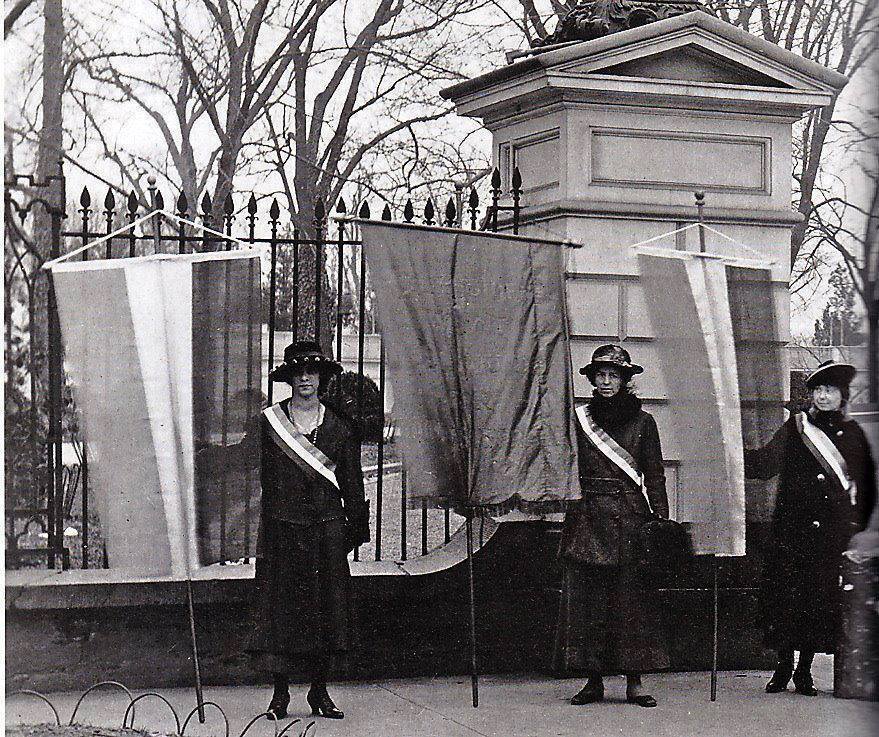
Today in Feminist History is our daily recap of the major milestones and minor advancements that shaped women’s history in the U.S.—from suffrage to Shirley Chisholm and beyond. These posts were written by, and are presented in homage to, our late staff historian and archivist, David Dismore.
January 10, 1917: “Silent Sentinels” have begun picketing President Wilson at the White House!
Twelve members of the Congressional Union for Woman Suffrage gathered together in formation outside the group’s headquarters, then with banners held high, marched to the White House gates. There they split into two groups of six, taking up their posts along the fence, next to each of the two entrances. Later in the day, they were relieved by twelve other troops.
True to their pledge to be “silent” sentinels, they let their banners speak for them. In response to yesterday’s meeting in which President Wilson refused to endorse the Susan B. Anthony (woman suffrage) Amendment, or pledge to do anything specific to help the cause, he cannot now enter or leave the White House without seeing a banner reading: “Mr. President, What Will You Do For Woman Suffrage?”
This is not the first time the President has seen this question. On December 5th, six women smuggled a similar banner into the House Gallery and unfurled it over the balcony while Wilson was delivering a speech to Congress. The large banner at each gate is surrounded by pickets carrying the unmarked, but more colorful purple, white and gold standards of the Congressional Union.

The commander of this well-disciplined army is Alice Paul, formerly of the National American Woman Suffrage Association. When NAWSA proved too conventional and conservative in its tactics, and more interested in achieving suffrage on a State-by-State basis than by a Constitutional amendment, Paul, Lucy Burns, and a few others formed the Congressional Union for Woman Suffrage. This way they could promote the Anthony Amendment and engage in more colorful and aggressive – though non-violent – actions. The two organizations have been rivals ever since, and today Carrie Chapman Catt, NAWSA’s President, said she thinks picketing the White House is an error.
The orders to the pickets today were as follows:
GENERAL ORDERS NO. 1:
Officer of the Day, Miss Mabel Vernon.
Sergeant of the Guard, Miss Mary Gertrude Fendall.GUARD MOUNT, Morning Detail, East Gate:
Privates—Miss Vivian Pierce, San Francisco; Miss Bertha Cron, San Francisco; Miss Mildred Gilbert, San Francisco; Miss Bessie Papandro, San Francisco; Miss Elizabeth Gary, Illinois; Miss Gertrude Crocker, Illinois.Morning Detail, West Gate:
Privates—Mrs. M.C. Dowell, Philadelphia; Miss Joy Young, District of Columbia; Miss Maud Jamison, Norfolk; Miss Elizabeth Smith, New York; Miss Pauline Floyd, Arkansas; Miss Frances Pepper, District of Columbia.BUGLER OF THE DAY—Press Bureau of the Congressional Union.
CHALLENGE—’Mr. President, What Will You Do For Woman Suffrage ?’
UNIFORM—Shoulder sashes.
Miss Alice Paul, Commandant.
Though he gave no reaction, President Wilson has definitely seen the banners, because they were up when he returned to the White House this morning after playing golf. There is also news about his reaction to the 300 suffragists who visited him yesterday and urged him to commit himself to helping the Anthony Amendment.
At a luncheon after the meeting, he apparently told one of the guests: “I certainly have had an ordeal today.” (If he thinks that brief and relatively friendly encounter was an “ordeal,” one can only imagine what he’ll consider this daily picketing of the entrances to the White House!)
Both the President and First Lady Edith Wilson went out for a second time today, and though the Chief Executive remained deliberately expressionless, his wife seemed startled by the pickets as the Presidential automobile sped away, so it was impossible to tell what she thought. Margaret Wilson, the President’s daughter from his first marriage, arrived at the White House just a bit later, and gave a friendly wave to the Sentinels. So, it appears that the pickets have at least one ally in the White House, though not, as yet, the one who can push the Anthony Amendment through Congress by putting pressure on his fellow Democrats.
The pickets will be here daily from 9:00 a.m. until 5:30 p.m., regardless of weather—or heckling by the public. That has already begun, though there have been shouts of support as well. So far the police have left them alone, since no one can seem to find a law that they’ve broken, though apparently that’s not due to any lack of effort on the part of the authorities to find one. The army is well-provisioned, thanks to $3,000 raised yesterday immediately after the campaign was proposed and adopted. Most of the money is being allocated for current needs, such as banners, umbrellas, and raincoats, with the rest kept in reserve for possible legal expenses in the future if the authorities manage to find or improvise an offense with which to charge the Sentinels.
Suffragists from all around the country have been sending telegrams to the Congressional Union today asking to either join the picket line or make monetary contributions, so the newspapers must be getting the word out nationwide about yesterday’s meeting with the President and the “Silent Sentinel” campaign launched just hours later.
Since there are plans for each of the 48 States to have a special day of picketing, recruits from outside the D.C. area are especially needed. After picketers from each State have had their turn, there will be days in which the pickets will all be of a certain profession, or graduates of a specific college, themes frequently used by delegations in suffrage parades and pageants.
“Commandant” Alice Paul is pleased with the results so far, and said today: “We shall keep it up until Congress passes our amendment or until the President helps us. Of course, when he helps, it will pass.”





